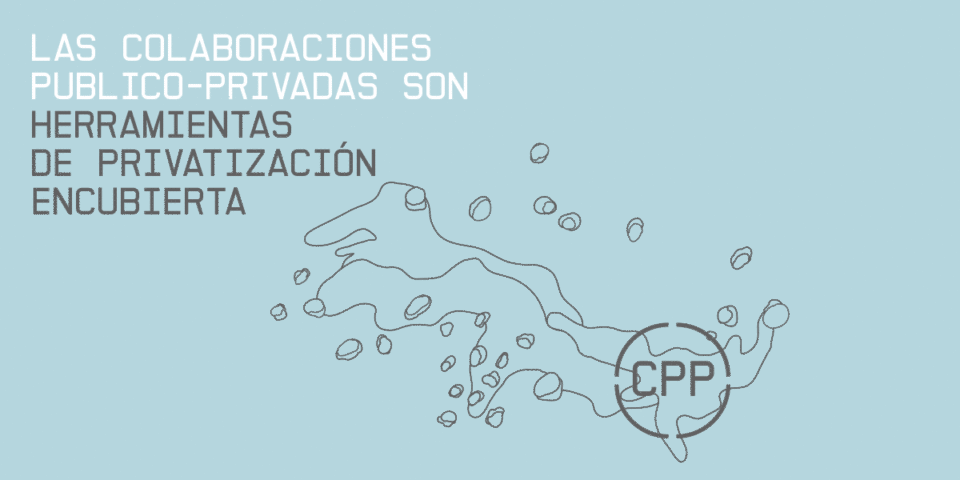The ODG report “Public-Private Partnerships (PPPs) as tools for privatisation” is a three-part publication that makes an x-ray of the legal framework of PPP contracts in the Spanish State, in addition to studying in depth the case of infrastructure, healthcare and education, placing us in the global framework, explaining the structural causes of this great push of undercover privatisations of our public services and goods, our commons. Available for download:
- The legal framework and the case of infrastructure (available in English on October 14th), by Nicola Scherer (ODG) and Rubén Martínez Moreno (La Hidra Cooperativa).
- The case of healthcare, by Auditoría Ciudadana de la Deuda en Sanidad (Audita Sanidad) and Nicola Scherer (ODG).
- The case of education, by Andrea Paola Galindo Vargas y Nicola Scherer (ODG).
Articles:
- La privatización encubierta de nuestros bienes y servicios públicos, published in La Marea on October 9th 2019, by Nicola Scherer and Emma Avilés.
- El lado oscuro de la “colaboración público-privada”, published in InfoLibre on October 18th 2019.
- La colaboración público-privada, en el corazón del conflicto en el hospital de Villalba, published in El Salto on October 17th 2019, by Audita Sanidad.
- Tombar la ‘Llei Aragonès’ o com frenar la privatització encoberta del sector educatiu, published in Crític on Octubre 29th 2019, by Nicola Scherer.
Following the EU warnings about deficiencies of the Spanish State regarding supervision and regulation of this type of contracts, first the conservative PP government created the National Evaluation Office (ONE) -which did not produce any results- and then the socialist PSOE government, since June 2018, created the Independent Office for Regulation and Supervision of Public Procurement (OIReScon), whose mission is to ensure the correct application of contract legislation and, in particular, to promote competition and combat illegalities and corruption in public procurement. PPPs in Spain fall into the Public Sector Contract Law (TRLCSP) and there is no specific legislation that regulates them. As of today, there are no publications on whether the mandate of the OIReScon regulatory body is being fulfilled, while there are plenty of examples of harmful PPP projects.
PPPs (ODG definition) came into existence in 1992 in the United Kingdom as an accounting trick used to avoid government restrictions on public debt, a feature that remains their main attraction for governments and international institutions. Their use has sky-rocketed with austerity imposition and privatisation policies as a way to balance budgets by hiding debt; they are undercover privatisations.
They are formulas for the private sector to build and manage sectors that have traditionally been in the public domain (such as health, education, transportation, infrastructure, etc.) and facilitate its participation therein. Backed by public guarantees, they transfer the risk to the public sector, and to citizens. Current PPP accounting practices allow governments to keep the project out of their balance sheets (they are not transparent or auditable), since it is the private sector -and not the government- who owns the loan that finances the project.
The results are overwhelmingly negative and few have achieved positive results for the public interest, exposing us to tremendous risks
- HIGHER COSTS: they are usually the most expensive method of financing, with high risks and often managed in an inefficient way.
- DEBT: there is a total lack of information on public guarantees in PPP projects; it is not possible to calculate exactly how much public debt could be created if the public sector has to save a private investment, converting private debt into public (illegitimate) debt.
- THREAT TO DEMOCRACY, LACK OF TRANSPARENCY AND CORRUPTION: they frequently undermine the right and obligation of the State to regulate in the public interest, they suffer from lack of transparency (with low contract publication rate, poor fiscal transparency, opaque and poor decision-making processes) and have limited public scrutiny, which in many cases leads to increased opportunities for corrupt behaviour. Neither do they guarantee free competition (contracts closed without prior publication).
- SOCIAL, ENVIRONMENTAL AND GENDER IMPACTS: PPPs can result in human, social, environmental and gender rights abuses, since what matters to the private investor is economic profitability, with a tendency to finance mega-projects with devastating climate impacts, destroying territories and ecosystems, and displacing entire communities, specially in the Global South.
Widespread proliferation of PPPs without evidence of their success in economic, social and environmental terms is inadequate. Strict regulation, supervision, democratic control and transparency are needed while moving towards a 100% public and/or public-community model.
– Not hiding their real costs and recognising their risks.
– Improving transparency and governance, with democratic participation processes where citizens have a say, and accountability for results.
– Tackling corruption and political-corporate collusion (facilities and gifts).
– Having a multi-criteria evaluation of projects -not only economic valuation-, with social, environmental and gender dimensions at the forefront.
– Improving the functioning of the public sector, whose investments in infrastructure are much higher than private ones (the ratio is 90% to 10%), and curb undercover privatisation.
Healthcare, education, transport and infrastructure, among others, are common services and goods for the entire population. They must be guaranteed in the Constitution as fundamental rights and protected against private interests.
References:
– The Castor Project is a paradigmatic example of Spanish PPP: it caused more than a thousand earthquakes and closed down without having operated for a single day. To the date, Castor has cost the public treasury about € 3.28 billion, which was initially charged on the backs of gas consumers, and has now become a multidimensional conflict pending resolutions and disputed by organised citizens through the Castor Case.
– PPP Manifesto: signed by 152 organizations from 45 countries against the PPP model.
– Council of Europe in its report “Public-private partnerships in the EU: Generalized deficiencies and limited benefits”.
